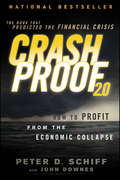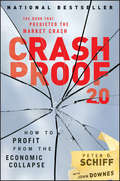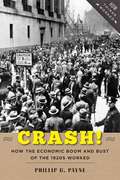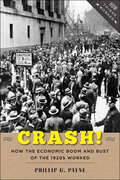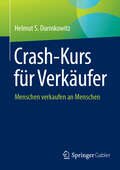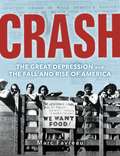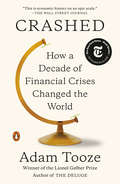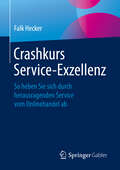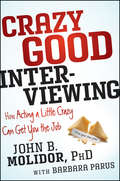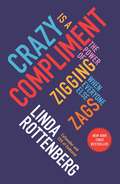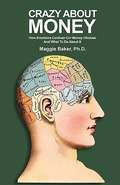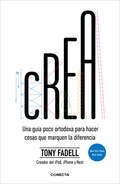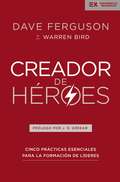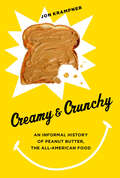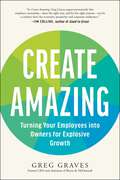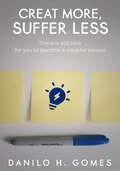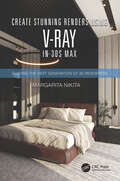- Table View
- List View
Crash Proof 2.0: How to Profit From the Economic Collapse
by Peter D. SchiffA fully updated follow-up to Peter Schiff's bestselling financial survival guide-Crash Proof, which described the economy as a house of cards on the verge of collapse, with over 80 pages of new material The economic and monetary disaster which seasoned prognosticator Peter Schiff predicted is no longer hypothetical-it is here today. And nobody understands what to do in this situation better than the man who saw it coming. For more than a decade, Schiff has not only observed the economy, but also helped his clients restructure their portfolios to reflect his outlook. What he sees today is a nation facing an economic storm brought on by growing federal, personal, and corporate debt; too little savings; and a declining dollar. Crash Proof 2.0 picks up right where the first edition-a bestselling book that predicted the current market mayhem-left off. This timely guide takes into account the dramatic economic shifts that are reshaping the world and provides you with the insights and information to navigate the dangerous terrain. Throughout the book, Schiff explains the factors that will affect your future financial stability and offers a specific three step plan to battle the current economic downturn. Discusses the measures you can take to protect yourself-as well as profit-during these difficult times Offers an insightful examination of the structural weaknesses underlying the economic meltdown Outlines a plan that will allow you to preserve wealth and protect the purchasing power of your savings Filled with in-depth insights and expert advice, Crash Proof 2.0 will help you survive and thrive during the coming years of economic uncertainty.
Crash Proof 2.0: How to Profit From the Economic Collapse
by Peter D. SchiffA fully updated follow-up to Peter Schiff's bestselling financial survival guide-Crash Proof, which described the economy as a house of cards on the verge of collapse, with over 80 pages of new material The economic and monetary disaster which seasoned prognosticator Peter Schiff predicted is no longer hypothetical-it is here today. And nobody understands what to do in this situation better than the man who saw it coming. For more than a decade, Schiff has not only observed the economy, but also helped his clients restructure their portfolios to reflect his outlook. What he sees today is a nation facing an economic storm brought on by growing federal, personal, and corporate debt; too little savings; and a declining dollar. Crash Proof 2.0 picks up right where the first edition-a bestselling book that predicted the current market mayhem-left off. This timely guide takes into account the dramatic economic shifts that are reshaping the world and provides you with the insights and information to navigate the dangerous terrain. Throughout the book, Schiff explains the factors that will affect your future financial stability and offers a specific three step plan to battle the current economic downturn. Discusses the measures you can take to protect yourself-as well as profit-during these difficult times Offers an insightful examination of the structural weaknesses underlying the economic meltdown Outlines a plan that will allow you to preserve wealth and protect the purchasing power of your savings Filled with in-depth insights and expert advice, Crash Proof 2.0 will help you survive and thrive during the coming years of economic uncertainty.
Crash! How The Economic Boom And Bust Of The 1920s Worked
by Phillip G. PayneSpeculation-an economic reality for centuries-is a hallmark of the modern U. S. economy. But how does speculation work? Is it really caused, as some insist, by popular delusions and the madness of crowds, or do failed regulations play a greater part? And why is it that investors never seem to learn the lessons of past speculative bubbles? Crash! explores these questions by examining the rise and fall of the American economy in the 1920s. Phillip G. Payne frames the story of the 1929 stock market crash within the booming New Era economy of the 1920s and the bust of the Great Depression. Taking into account the emotional drivers of the consumer market, he offers a clear, concise explanation of speculation's complex role in creating one of the greatest financial panics in U. S. history. Crash! explains how post-World War I changes in the global financial markets transformed the world economy, examines the role of boosters and politicians in promoting speculation, and describes in detail the disastrous aftermath of the 1929 panic. Payne's book will help students recognize the telltale signs of bubbles and busts, so that they may become savvier consumers and investors.
Crash!: How the Economic Boom and Bust of the 1920s Worked (How Things Worked)
by Phillip G. PayneThe irrationally exuberant highs and lows of the 1920s can help students recognize boom and bust cycles past, present, and future.Speculation—an economic reality for centuries—is a hallmark of the modern U.S. economy. But how does speculation work? Is it really caused, as some insist, by popular delusions and the madness of crowds, or do failed regulations play a greater part? And why is it that investors never seem to learn the lessons of past speculative bubbles? Crash! explores these questions by examining the rise and fall of the American economy in the 1920s.Phillip G. Payne frames the story of the 1929 stock market crash within the booming New Era economy of the 1920s and the bust of the Great Depression. Taking into account the emotional drivers of the consumer market, he offers a clear, concise explanation of speculation's complex role in creating one of the greatest financial panics in U. S. history.Crash! explains how postWorld War I changes in the global financial markets transformed the world economy, examines the role of boosters and politicians in promoting speculation, and describes in detail the disastrous aftermath of the 1929 panic. Payne's book will help students recognize the telltale signs of bubbles and busts, so that they may become savvier consumers and investors.
Crash-Kurs für Verkäufer: Menschen verkaufen an Menschen
by Helmut S. DurinkowitzIn diesem Buch erfahren Sie die einfachen, aber wirkungsvollen Strategien und Techniken, mit denen Top-Verkäufer zuverlässig erfolgreiche Abschlüsse erzielen. Mit einem klaren, systematischen Ansatz erläutert der Autor die wichtigsten Verkaufsphasen – von der Akquisition bis zum Abschluss. Die vermittelten Methoden sind so konzipiert, dass sie von jedem Verkäufer leicht angewendet und wiederholt werden können. Eine unverzichtbare Lektüre für alle, die im Verkauf tätig sind und langfristig erfolgreich sein wollen! Mit wertvollen Tipps für alle Arten der Neukundenakquise, das Verhalten am Messestand und anderen Verkaufswerkzeugen.
Crash: The Great Depression and the Fall and Rise of America
by Marc FavreauThe incredible true story of how real people weathered one of the most turbulent periods in American history—the Great Depression—and emerged triumphant. From the sweeping consequences of the stock market crash to the riveting stories of individuals and communities caught up in a real American dystopia, discover how the country we live in today was built in response to a time when people from all walks of life fell victim to poverty, insecurity, and fear. Meet fascinating historical characters like Herbert Hoover, Franklin Delano and Eleanor Roosevelt, Frances Perkins, Dorothea Lange, Walter White, and Mary McLeod Bethune. See what life was like for regular Americans as the country went from the highs of the Roaring Twenties to the lows of the Great Depression, before bouncing back again during World War II. Explore pivotal scenes such as the creation of the New Deal, life in the Dust Bowl, the sit-down strikes in Michigan, the Scottsboro case, and the rise of Father Coughlin. Packed with photographs and firsthand accounts, and written with a keen understanding of the upheaval of the 1930s, Crash shares the incredible story of how America survived—and, ultimately, thrived.
Crashed: How a Decade of Financial Crises Changed the World
by Adam ToozeFrom a prizewinning economic historian, an eye-opening reinterpretation of the 2008 economic crisis (and its ten-year aftermath) as a global event that directly led to the shockwaves being felt around the world today. <p><p> In September 2008 President George Bush could still describe the financial crisis as an incident local to Wall Street. In fact it was a dramatic caesura of global significance that spiraled around the world, from the financial markets of the UK and Europe to the factories and dockyards of Asia, the Middle East, and Latin America, forcing a rearrangement of global governance. In the United States and Europe, it caused a fundamental reconsideration of capitalist democracy, eventually leading to the war in the Ukraine, the chaos of Greece, Brexit, and Trump. <p> It was the greatest crisis to have struck Western societies since the end of the Cold War, but was it inevitable? And is it over? Crashed is a dramatic new narrative resting on original themes: the haphazard nature of economic development and the erratic path of debt around the world; the unseen way individual countries and regions are linked together in deeply unequal relationships through financial interdependence, investment, politics, and force; the ways the financial crisis interacted with the spectacular rise of social media, the crisis of middle-class America, the rise of China, and global struggles over fossil fuels. Finally, Tooze asks, given this history, what now are the prospects for a liberal, stable, and coherent world order?
Crashkurs Service-Exzellenz: So heben Sie sich durch herausragenden Service vom Onlinehandel ab
by Falk HeckerService-Exzellenz: Mit diesem Buch heben Sie sich von der Konkurrenz abIn diesem Buch über Service-Exzellenz erhalten Mitarbeiter in der Dienstleistungsbrache und im Verkauf wertvolle Tipps, wie sie trotz des zunehmenden Wettbewerbs durch den Onlinehandel dauerhaft Kunden für sich gewinnen können. Schließlich wird das Einkaufen im Internet immer anonymer und der persönliche Kundenkontakt seltener. Wenn jedoch Verkäufer und Kunde persönlich aufeinander treffen, ist das eine große Chance, sich mit herausragendem Service von Onlineanbietern abzugrenzen. Ware ist austauschbar – Menschen, die außergewöhnlichen Service bieten, dagegen nicht. Dieses Buch enthält eine Fülle von Beispielen, Tipps und praktischen Werkzeugen für Service-Exzellenz, mit denen Sie sich positiv vom Onlinehandel und von Mitbewerbern abheben. Hier erfahren Sie, wie Sie Ihr Auftreten verbessern, Mitarbeiter erfolgreich führen und motivieren und dadurch die Kundenzufriedenheit steigern, um letztendlich Ihre Vertriebsziele zu erreichen. So senden Sie die richtigen Signale Untergliedert in sechs Abschnitte erfahren Sie in diesem Buch zunächst mehr über die wichtige Rolle der Wertschätzung im Service. Lesen Sie, was eine gute Begrüßung ausmacht und wie Sie bei einer neuen Begegnung schnell die Sympathien potenzieller Kunden für sich gewinnen. Die folgenden Kapitel bringen Ihnen außerdem noch diese Serviceaspekte näher:Fragetechnik: Wer fragt, der führtKörpersprache: Die nonverbalen BotschaftenEinstellung: Wahre Motivation kommt von InnenVertrauen: Die größte Ehre, die wir dem Kunden antun könnenAutorität: Service braucht AugenhöheEntscheiden: Weniger ist häufig mehrTransparenz: Bewertungen sind das A & O im digitalen ZeitalterVerkaufen ist ein komplexer VorgangWie der Inhalt dieses Buchs zeigt, ist Service-Exzellenz nicht nur ein reiner Verkaufsprozess. Vielmehr geht es um zwischenmenschliche Handlungen, die sich zeitgleich auf einer psychologischen, soziologischen und philosophischen Ebene abspielen. Daher ist dieses Werk für alle Beschäftigten in Handels- oder Dienstleistungsunternehmen eine echte Empfehlung, um Kundenbindung und -begeisterung im Verkauf nachhaltig zu sichern.
Cravia: Launching High Growth Ventures in the Middle East
by Michael Norris Lynda M. ApplegateWalid Hajj (HBS '95), CEO of Dubai-based restaurant franchising company Cravia considers how best to expand his business in the fast-growing Gulf region. Should he add more American brands, expand to nearby countries, or open more of his current lineup of restaurants?
Cravia: Launching High Growth Ventures in the Middle East
by Michael Norris Lynda M. ApplegateWalid Hajj (HBS '95), CEO of Dubai-based restaurant franchising company Cravia considers how best to expand his business in the fast-growing Gulf region. Should he add more American brands, expand to nearby countries, or open more of his current lineup of restaurants?
Crazy Good Interviewing: How Acting A Little Crazy Can Get You The Job
by John B. MolidorHow acting a little crazy and thinking outside of the box can get you the job you want Ever hear of a job candidate stretching out on the interviewer's floor to fill out an application? Or an applicant who sees nothing wrong with texting during the interview? Securing a job interview is a golden opportunity. The crazy-bad behavior described above will not net a job offer. Crazy Good Interviewing shows readers that crazy-good behavior, however, can make an applicant stand out favorably in a sea of mediocrity. Take the candidate who created a keynote presentation on his iPad to show what he could bring to the job or the one who created a DVD highlighting her abilities. Crazy Good Interviewing is a book geared toward those who are looking for work in this tough economy. Addresses how slightly eccentric behaviors can tip the scales in the applicant's favor Delves into how to access your three key strengths, how to use body language effectively, how to prepare a five-sentence history that builds a bridge to the interviewer, and more Turn just plain crazy into crazy-good, and land the job at your next interview.
Crazy Is a Compliment
by Linda Rottenberg"If people aren't calling you crazy, you aren't thinking big enough." These days taking chances isn't just for college dropouts in hoodies. Whether you work at a Fortune 500 company, a nonprofit, or a mom-and-pop, everybody needs to think and act like an entrepreneur. We all need to be nimble, adaptive, daring--and maybe even a little crazy--or risk being left behind. But how do you take smart risks without risking it all? That's Linda Rottenberg's expertise. As the cofounder and CEO of Endeavor, the world's leading organization dedicated to supporting fast-growing entrepreneurs, she's spent the last two decades helping innovators think bold and execute smart. Now Rottenberg draws on her unrivaled experience to show you the proven techniques to achieve your dreams: from overcoming fear to facing down critics, from stalking supporters to exploiting chaos. Crazy Is a Compliment combines inspiring stories, original research, and practical advice to create a road map for getting started and going bigger. Rottenberg brings to life iconic entrepreneurs like Walt Disney and Estée Lauder and reveals how companies like MTV, GE, and Burberry found their best successes by breaking the corporate mold and embracing the entrepreneur mind-set. She also introduces us to some of the one thousand entrepreneurs she's advised, like Leila Velez, who started a hair-care company in her kitchen sink in Rio that now earns $80 million a year. As Linda writes: Every day I meet people with a dream. Maybe you're serving coffee and fantasizing about launching a microbrewery; maybe you've skipped college and yearn to start your own design firm; maybe you're sitting in your cubicle and brainstorming a new idea that can improve your company. You have a dream, but you don't know how to turn your dream into reality. Or you've already launched your dream but you're unsure how to take it to the next level. This book can show you the way.
Crazy about Money: How Emotions Confuse Our Money Choices and What to Do about It
by Maggie BakerThe book discusses what money means to us, where our beliefs come from, and how we develop money behavior from childhood through young adulthood and into our older years and focuses on how we use money--be it investing, borrowing, gambling, or leaving a legacy. Baker presents the stories of people she has worked with. By absorbing the stories' lessons, doing the exercises, and applying what you have learned to your own money situation, you will know how to make better money choices for yourself.
Crea il tuo piano di Trading redditizio in 5 passi
by Álvaro CidA molte persone piacerebbe poter investire in borsa e guadagnare denaro fino al punto di vivere solo di questo. Ma hanno un piccolo problema: non sanno come fare. Alcune persone hanno anche iniziato a investire in borsa con scarsi risultati. A questo punto la maggioranza abbandona e si convince che investire sia una cosa molto rischiosa per chiunque. Tristemente la maggioranza non otterrà il rendimento che si aspettava dal mercato. La presente guida ti aiuterà a creare il tuo metodo o il tuo piano di trading specifico. Ho progettato questi passi dopo anni di tentativi ed errori sul mercato e sulla mia metodologia di investimento; in questo modo potrai ottenere i risultati positivi che desideri dal mercato se segui questi semplici passi. Potrai creare un piano di Trading con questo metodo se: Sei un trader navigato che conosce le regole di entrata e di uscita dal mercato e vuoi inserire tutto in un metodo solido e redditizio. Sei un trader novizio agli inizi e hai bisogno di imparare i passi corretti fin dal primo momento. Hai voglia di guadagnare denaro sul mercato in modo professionale.
Crea: Una guía poco ortodoxa para hacer cosas que marquen la diferencia
by Tony Fadell«He colaborado en cambiar el mundo dos veces: con el iPod y con el iPhone. Ahora quiero la oportunidad de hacerlo por tercera vez» - TONY FADELL Una guía poco ortodoxa para crear innovaciones que marquen la diferencia, de mano del padre del iPod y el iPhone. Tony Fadell es un mito de la innovación y comparte en estas páginas su experiencia y su aprendizaje en algunas de las más destacadas compañías de los últimos treinta años, como Apple, Nest y Google, en el desarrollo de productos tecnológicos. En este libro, estructurado como una enciclopedia, recoge todo lo que ha aprendido: lecciones sobre liderazgo, innovación, pensamiento disruptivo, emprendimiento, éxito y fracaso, combinadas con historias personales de su carrera y de su trabajo con figuras de la talla de Steve Jobs o Larry Page. Un relato en primera persona de una época crucial, un retrato íntimo de algunos de los líderes más destacados de los últimos treinta años. Un legado para los genios del mañana. Reseñas:«Tony Fadell es uno de los grandes expertos mundiales en fundar compañías y crear productos increíblemente geniales. Este libro destila su sabiduría y aporta orientación en un conjunto de historias apasionantes».Walter Isaacson, autor y biógrafo de Steve Jobs, Albert Einstein y Leonardo da Vinci «Tony Fadell ha creado más cosas geniales que nadie en toda la historia de Silicon Valley, y en Crea nos explica cómo lo ha hecho. Es la biografía más divertida y fascinante sobre curiosidad e ingenio que he leído nunca».Malcolm Gladwell, autor de Fuera de serie y Hablar con extraños «Basándose en su propia y difícil experiencia como emprendedor, Tony Fadell ofrece en Crea consejos valiosos para cualquier joven que quiera construir algo magnífico o cambiar el mundo para mejor. Ojalá yohubiera leído este libro cuando tenía veintiún años».Ben Horowitz, socio fundador de Andreessen Horowitz «Revelador. Divertido. Instructivo. Sin adornos. En este libro, lleno de energía y entusiasmo, Tony Fadell, creador de productos que han definido épocas enteras, hace uso de su experiencia con el éxito y el fracaso para ayudarte en todos los pasos de tu carrera».Joanna Hoffman, exvicepresidenta de marketing de General Magic y miembro del equipo original de Macintosh «Tony Fadell resume su épica carrera en un conjunto de consejos claros, y a menudo opuestos, que puedes poner en práctica de inmediato. Tanto si buscas crear un gran producto, como si aspiras a crear un equipo creativo, una cultura más sólida o una carrera con más significado, la guía de Tony te hará pensar y repensar».Adam Grant, autor de Piénsalo otra vez y Originales
Creación de Equipos y Dirección Dinámica de Grupos
by Hiriyappa. B Traductora Elizabeth GarayEste libro trata sobre la formación de equipos y la administración dinámico de grupos. Determina qué es un equipo, cuántos tipos existen y las funciones, responsabilidades y normas de los integrantes del equipo. Ofrece información esencial para la integración de equipos en una organización y la manera de convertirlos en efectivos y eficientes.
Creador de héroes: Cinco prácticas esenciales para la formación de líderes (Exponential Series)
by Dave Ferguson Warren Bird“Cada iglesia tiene una historia diferente”, dice el empresario y pastor Patrick O'Connel, “pero todas las iglesias necesitan una instancia clara de desarrollo de liderazgo para los líderes, tanto voluntarios como pagos. Lo que a menudo falta es un camino que conduzca a la multiplicación”.A partir de las prácticas de Jesús, este libro se enfoca en ayudar a los líderes a trazar y refinar su camino hacia el desarrollo del liderazgo, proporcionando orientación y ejemplos específicos de diferentes iglesias para obtener las mejores habilidades.Creador de héroes guía a los líderes a lograr cinco cambios clave, comenzando con el secreto de toda multiplicación de liderazgo exitosa: convertir a los otros en héroes en la historia de la obra de Dios. Otros cambios incluyen aprender a convertirse en un multiplicador de discípulos, un dador de permisos, un activador de dones y un edificador del Reino comprometido con la misión global de Dios.Los líderes de la iglesia aprenderán lo que significa convertirse en una iglesia de "Nivel 5", redefiniendo el éxito de una iglesia no por su crecimiento numérico, sino por el hecho de ser o no una iglesia en reproducción y multiplicación. También se incluyen ilustraciones y ejercicios sobre cómo desarrollar aprendices, liderar grupos pequeños y liderar líderes.
Creamy & Crunchy: An Informal History of Peanut Butter, the All-American Food (Arts and Traditions of the Table Perspectives on Culinary History)
by Jon Krampner&“A delightful book about America&’s most popular nut butter and sandwich spread . . . well-written, fast-paced, surprising.&”—Andrew F. Smith, editor in chief, The Oxford Encyclopedia of Food and Drink in America Americans spoon it out of the jar, eat it in sandwiches by itself or with its bread-fellow jelly, and devour it with foods ranging from celery and raisins (&“ants on a log&”) to a grilled sandwich with bacon and bananas (the classic &“Elvis&”). Peanut butter is used to flavor candy, ice cream, cookies, cereal, and other foods. It is a deeply ingrained staple of American childhood. Along with cheeseburgers, fried chicken, chocolate chip cookies (and apple pie), peanut butter is a consummate comfort food. In Creamy and Crunchy are the stories of Jif, Skippy, Peter Pan; the plight of black peanut farmers; the resurgence of natural or old-fashioned peanut butter; the reasons why Americans like peanut butter better than (almost) anyone else; the five ways that today&’s product is different from the original; the role of peanut butter in fighting Third World hunger; and the Salmonella outbreaks of 2007 and 2009, which threatened peanut butter&’s sacred place in the American cupboard. To a surprising extent, the story of peanut butter is the story of twentieth-century America, and Jon Krampner writes its first popular history, rich with anecdotes and facts culled from interviews, research, travels in the peanut-growing regions of the South, personal stories, and recipes. &“A witty, encyclopedic history of one of America&’s most iconic processed foods. It is chock-full of fun facts and surprising insights into the way we eat today.&”—Aaron Bobrow-Strain, author of White Bread: A Social History of the Store-Bought Loaf
Creamy and Crunchy: An Informal History of Peanut Butter, the All-American Food (Arts and Traditions of the Table: Perspectives on Culinary History)
by Jon KrampnerMore than Mom's apple pie, peanut butter is the all-American food. With its rich, roasted-peanut aroma and flavor; caramel hue; and gooey, consoling texture, peanut butter is an enduring favorite, found in the pantries of at least 75 percent of American kitchens. Americans eat more than a billion pounds a year. According to the Southern Peanut Growers, a trade group, that's enough to coat the floor of the Grand Canyon (although the association doesn't say to what height).Americans spoon it out of the jar, eat it in sandwiches by itself or with its bread-fellow jelly, and devour it with foods ranging from celery and raisins ("ants on a log") to a grilled sandwich with bacon and bananas (the classic "Elvis"). Peanut butter is used to flavor candy, ice cream, cookies, cereal, and other foods. It is a deeply ingrained staple of American childhood. Along with cheeseburgers, fried chicken, chocolate chip cookies (and apple pie), peanut butter is a consummate comfort food. In Creamy and Crunchy are the stories of Jif, Skippy, Peter Pan; the plight of black peanut farmers; the resurgence of natural or old-fashioned peanut butter; the reasons why Americans like peanut butter better than (almost) anyone else; the five ways that today's product is different from the original; the role of peanut butter in fighting Third World hunger; and the Salmonella outbreaks of 2007 and 2009, which threatened peanut butter's sacred place in the American cupboard. To a surprising extent, the story of peanut butter is the story of twentieth-century America, and Jon Krampner writes its first popular history, rich with anecdotes and facts culled from interviews, research, travels in the peanut-growing regions of the South, personal stories, and recipes.
Create Amazing: Turning Your Employees into Owners for Explosive Growth
by Greg GravesAre you considering starting an Employee Stock Ownership Plan (ESOP) or converting your company to an ESOP? Or maybe making the big leap to a 100% employee-owned company? If you want your company to perform at its absolute peak and you want the people who make that happen (you included) to receive the ultimate financial return—that of an owner—Create Amazing is your practical field guide to creating an amazing company and leaving a great legacy. There are more than 10,000,000 employee owners in America today. The results of employees owning a piece of the pie has been proven throughout American history, even before ESOPs became IRS law in 1974. Employees with even a small capital interest in their firms' successes are more likely to stay, have greater loyalty and pride, are willing to work hard, and make more suggestions for improvement. Economic injustice caused by wealth disparity is quickly becoming the hottest debated topic in America especially in combination with the most regressive recession in America's history and the nation's hopeful new commitment to equalizing opportunities across all people. Employee ownership is not the only answer for economic justice but it can be a critical puzzle piece for tens of millions of Americans where the current inherent disadvantage of circumstance stands in their way. Create Amazing demonstrates how ownership can provide the ultimate competitive advantage to a growing company—and the nation. The vast majority of what's been published about employee ownership comes from academe—compelling research from Rutgers, the feds, and several national ESOP associations. Create Amazing puts ESOPs feet-on-the-ground, written by Greg Graves, a CEO who has walked the talk. Graves operated one of the most successful ESOPs in American history. Graves shares: The history of employee ownership in America and the principles of its purpose Why employee ownership is a viable solution fiscally and futuristically What an ESOP is, what it does, and what's happening in Washington, DC, to promote this model How ESOPs work, and how they're structured legally, fiduciarily, and financially A deep dive into the impact of ESOPs on America and on employee owners personally If you're a business owner considering an ESOP start-up or transition to employee ownership, if you are a current employee owner who believes your firm can do more, or if you simply believe that our nation needs a shot of steroids to be both more productive and more just, this is the book that speaks from a real-world, executive-to-executive perspective about the process, the problems (and how to avoid them), and the deliverables. Create Amazing explores how employee ownership—done the right way—sparks an ownership mindset among employees and can be a catalytic force for economic prosperity and corporate endurance.
Create More, Suffer Less: There is still time for you to become a creative person
by Danilo H. GomesYou can easily enhance your creativity with the help of some exercises and appropriate techniques. Nowadays it is very common to listen to people complaining about their lack of creativity and their fear to move forward in certain areas of life. But one thing is sure: every person has potential creativity. The only problem is the fact that they don´t know the effective methods to put it into practice. CREATE MORE; SUFFER LESS keeps the promise of its title. The book gives the reader a useful set of tips, exercises and techniques, which will open up the doors of creativity. It will be a valuable help whenever you search for new ideas. It will help you discover your creative side and lead to positive results in all walks of life.
Create Short-Term Wins: Reinforcing the Change Effort
by Dan S. CohenShort-term wins that are timely, visible, and meaningful are critical to building the credibility needed to sustain the change effort over time. But delivering short-term results can be a challenge. This chapter provides exercises and assessment tools to help you overcome this challenge, outlining the steps you can take to maximize the benefits of short-term wins and bolster your change effort.
Create Short-Term Wins: Toward Successful Large-Scale Change
by John P. Kotter Dan S. CohenPeople are more likely to endorse change when they have short-term, achievable goals. Sufficient wins that are visible, timely, unambiguous, and meaningful to others, motivate people and hasten change.
Create Stunning Renders Using V-Ray in 3ds Max: Guiding the Next Generation of 3D Renderers
by Margarita NikitaCreate Stunning Renders using V-Ray in 3ds Max: Guiding the Next Generation of 3D Renderers is a step-by-step guide on how to create realistic renderings using V-Ray in 3ds Max. The potentials of V-Ray are detailed using a bedroom scene as an example. The book introduces the 3ds Max interface and the basic commands, allowing readers to familiarize themselves with the work environment from the very beginning. This book is intended for architects, interior designers, and anyone else wanting to create photorealistic renderings using V-Ray in 3ds Max. The reader does not need experience to follow this book, but any prior knowledge of working in 3ds Max will help the reader jump right in. Margarita Nikita is the co-founder of High Q Renders LLC, an award-winning creative company based in San Francisco, CA, with offices in Greece. Nikita has published several design books on 2D and 3D graphic design, some of which are used in university courses, actively contributing to the formation of the new generation of 3D modelers in her native country, Greece. She shares her knowledge, advice, and tips and tricks on her YouTube channel, Margarita Nikita. More of her work is available at her Instagram account, @margarita.nikita.
Create The Future: Tactics For Disruptive Thinking
by Jeremy GutscheCreate the Future is an exciting, highly-visual guidebook for disruptive thinking, innovation, and change, paired with The Innovation Handbook, an updated version of the award-winning book, Exploiting Chaos. The 360-page bestseller is loaded with the same tactics, tools and frameworks that Gutsche's team uses to accelerate 700 of the world's most powerful brands, billionaires, CEOs and NASA. In short, you are capable of much more than you think, and our current period of chaos in presenting you with a unique window of opportunity. COVID-19 has entirely reshuffled the deck, and changed consumer needs. Millions of businesses have already been disrupted, many more are about to fail, and yet, new consumer needs are creating an opportunity that could reshape your future. Throughout history, we know that chaos reshuffles the deck, changes consumer needs, switches who is in the lead, and creates unprecedented risk and opportunity. Chaos causes most people to retreat - but not always. Disney, CNN, Square, HP, Apple, Fortune Magazine, Uber and AirBnB are just a few examples of companies that started during periods of rampant chaos and global economic recession. Crisis and chaos CREATE opportunity, if you know where to look. The challenge is that your own success, neurological wiring, past decisions, and "7 Traps of Path Dependency" make it more difficult for you to realize your full potential.
